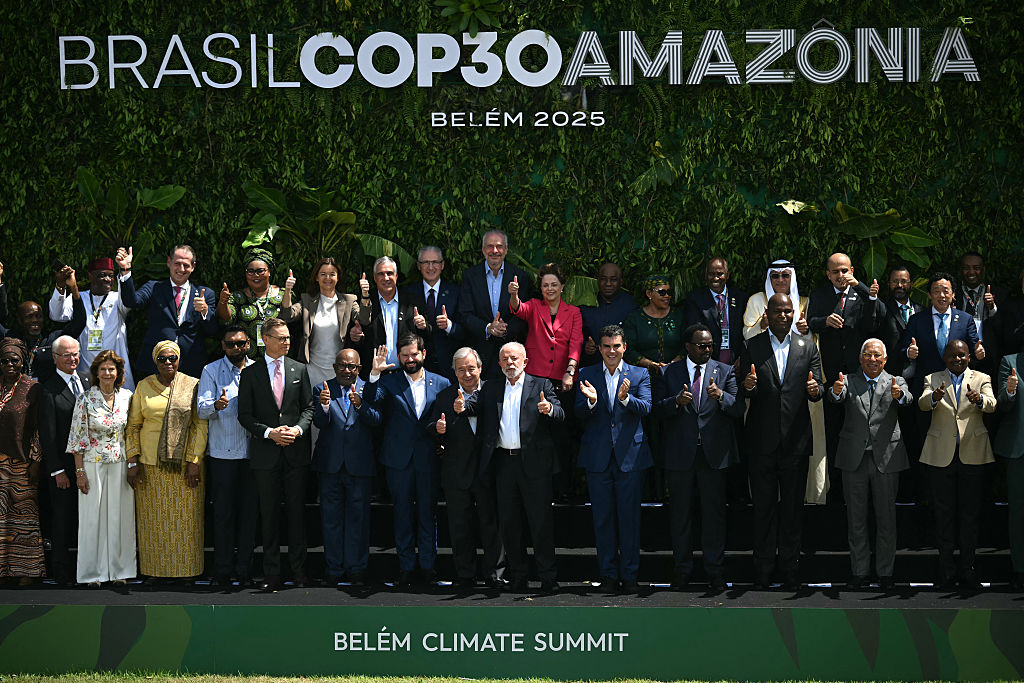Why investors may need to pivot from ESG towards carbon-intensive industries
Investors have been keen to show their green credentials by shunning carbon-intensive industries. The cost of that virtue signalling is now becoming apparent, says Frédéric Guirinec.

The road to hell is paved with good intentions. Fears of global warming have created massive enthusiasm for “green investing” over the past few years. Industries that furthered the goal of cutting emissions – such as renewable energy – have found it easier to raise capital. Financial institutions have allocated more money to environmental, social and governance (ESG) strategies in general. Funds claiming to follow ESG principles now manage $6.1trn, representing 10% of worldwide fund assets, mostly in Europe.
Asset managers have shown that they are willing to use their power to structurally shift our economies. The five largest investment managers – BlackRock, Vanguard, UBS, State Street and Fidelity – hold a combined $22.5trn in assets, giving them an enormous amount of clout if they act together.
Last year we saw an example of them doing so, when several backed an activist hedge fund in voting three directors off the board of oil major Exxon Mobil. Meanwhile, banks and insurance companies are making “net zero” commitments not just at company level but also at the portfolio level – which is affecting where they are willing to invest and lend.
MoneyWeek
Subscribe to MoneyWeek today and get your first six magazine issues absolutely FREE

Sign up to Money Morning
Don't miss the latest investment and personal finances news, market analysis, plus money-saving tips with our free twice-daily newsletter
Don't miss the latest investment and personal finances news, market analysis, plus money-saving tips with our free twice-daily newsletter
There is an obvious problem with this. Many of the industries being shunned by ESG-conscious investors and lenders remain crucial to the way the world works. Sectors that emit large amounts of carbon dioxide (directly or indirectly) include energy, mining, heavy industries such as metals and chemicals, farming and transport. We may not like this, but we can’t immediately replace them: 80% of the energy consumed in the world is still generated from fossil fuels.
The consequence of several years of lower investment in these out-of-favour sectors was already becoming apparent in the second half of 2021: the Bloomberg Commodity Spot index hit an all-time high in October as rising demand collided with tight supply. The Russian invasion of Ukraine brought matters to a head.
We need affordable, secure energy
Investment in oil and gas has been depressed over the past six years and discoveries are at the lowest for the last 75 years, according to Rystad Energy, a Norwegian energy-intelligence firm. Surging oil and gas prices have huge consequences financially – Citigroup estimates the primary energy bill for Europe will reach $1trn this year, close to the record levels of 2007 and 2011. It also has both energy security and environmental implications.
The UK and Europe have to import liquefied natural gas (LNG) from the US – gas that was produced using highly polluting fracking techniques. Reducing European reliance on Russian oil and gas will require intensive capital expenditure in other geographies, not least because all types of oil are not the same and supplies need to be matched to refinery capacity – light, sweet (low-sulphur) crude is easier to refine than heavy, sour (high-sulphur) oil.
Despite the obvious need for more investment and the likelihood that oil prices will remain elevated, the shares of European oil majors have remained flat since the beginning of the year, unlike their American counterparts. That may reflect their exposure to Russia, but also probably, at least in part, the fact that oil is now a taboo sector for some increasingly ESG-conscious investors – ie, today’s equivalent of tobacco.
Firms such as BP and Total offer interesting value in a world where energy is more scarce. However, the most risk-seeking investor may look at the extremely cyclical offshore oil drilling sector, where consolidation is under way and major companies such as Odfjell Drilling and Maersk Drilling should emerge stronger. Canada’s oil sands produce some of the world’s most carbon-intensive crude, but shares of Imperial Oil and Canadian Natural Resources are rising, reflecting renewed interest from investors in the sector.
Of course, it’s not just oil. The transition to die Energiewende (a long-term renewable energy and climate strategy) favoured by Germany has been close to a disaster this winter. Back in October, several European countries warned of potential blackouts and electricity prices shot up due to low wind power generation.
Prices of natural gas for gas-fired power stations – the back-up for wind – soared as well, and stocks fell to all-time lows. The uncertainty of whether Russia (which supplies 40% of Europe’s gas) could turn off the tap at any moment has really demonstrated the fatal flaws in European energy policy.
On the European continent, some factories had to stop or limit production – compounding supply-chain issues – while others began acquiring their own fuel generators to get off the grid immediately. Poland took a different approach.
The government decided that it would continue to exploit the Turow coal mine near the border with the Czech Republic – and would ignore a €50,000 daily fine levied by the European Union to do so. Coal and cheap but highly polluting lignite (brown coal) generates 75% of Poland’s electricity, and the transition to nuclear energy will take some years.
Poland is not the only country deciding that it would rather increase pollution than run short of energy. China, which has tripled its production of coal since 2000, announced a ban on coal exports and is increasing investments in mining to ensure energy security. The reality is that annual world coal consumption still stands at 8.5 billion tons and has not declined much in recent years.
That is why miner Glencore is betting that coal will still be relevant. Its share price is up by 50% year on year as investors come round to the same view. The other big winner may be nuclear energy, which provides about 30% of the world’s low-carbon electricity. France and the UK are both now planning to expand their nuclear capacity to produce carbon-free electricity and meet climate objectives.
This will benefit uranium miners such as Cameco and Energy Fuels. In contrast to coal – which is hard to greenwash – nuclear is undergoing a makeover. The EU now plans to label some nuclear projects – and even some gas ones – as green. You can argue about whether any power that leaves toxic waste to be stored for thousands of years can really be environmentally friendly, but this decision illustrates both the limits of ESG semantics and the risks to our economies of running out of affordable energy.
An electric economy
still needs metals Meanwhile, metals such as aluminium, copper and zinc have all reached elevated levels. Some of this is due to speculation and more recently to sanctions on Russia, and these levels may not be fully sustainable, but there is a real lack of supply. This has been exacerbated by rising demand for some metals caused by the electrification of the economy – another key green theme where the impact on raw materials has been underestimated.
Large miners such as Rio Tinto, BHP and Glencore offer exposure to various metals. Other peers look even cheaper. Anglo American trades on an enterprise value (EV – market capitalisation plus debt) of only 4.1 times earnings before interest, tax depreciation and amortisation (Ebitda) and carries nearly no debt. It regrettably spun off its coal business, Thungela Resources, under ESG pressure last year.
Thungela’s share price has shot up fivefold since its initial public offering in June. Glencore shareholders should probably hope that their company can resist any similar pressure to get rid of its coal operations. Many other miners are also trading at depressed valuations – for example, Nexa Resources, which extracts zinc in Latin America, is on an EV/Ebitda ratio of three and generates 28% Ebitda margins.
Though gold and silver pulled back last year because markets expect a series of increases in interest rates, prices are now resilient and gold miners are priced extremely cheaply. Many are poorly managed and operate in difficult geographies (such as Mali, Peru and Russia), but some generate healthy and steady cash flows. I favour Barrick Gold.
Makers of metals such as steel, aluminium or zinc have different dynamics to miners or energy – their fortunes depend on whether demand and prices for their finished products outstrip raw material costs (metal ores and energy). If we start to see shortages in output here at the moment, it’s not – broadly speaking – about a shortfall in capacity, but rather a shortage of affordable inputs (specifically energy, which is hurting many producers in Europe).
Nonetheless, the market value of steel companies is historically broadly correlated to commodity prices, according to consultancy McKinsey, albeit to a lesser extent than primary producers (there’s a 64% correlation for the steel sector, compared with 84% for oil and gas, and 93% for miners). Steel makers such as ArcelorMittal and Ternium are seeing their shares rally, yet trade at EV/Ebitda ratios of less than two, while generating strong profit margins. This is a notoriously cyclical industry and investors are right to treat it with caution – but today’s aversion to energy-intensive, carbon-spewing sectors may still leave it cheaper than fundamentals would suggest.
Conditions are hurting aluminium producers more: aluminium smelting is extremely energy intensive (and carbon intensive) and so rising energy prices have slashed margins. Unable to fully pass on prices, producers have been shutting down some capacity, which was already leading to tighter supply. The war in Ukraine has now upended matters: Russia is the second largest producer of aluminium outside China, with around 6% of global production, and this may be taken out of the market due to sanctions. Thus shares of efficient producers such as Alcoa, which had been steadily recovering from its 2020 lows, are holding up despite the headwinds.
How gas prices caused a fertiliser crisis
Refineries and petrochemical plants are not the ESG investor’s best friend, either: they take in oil or gas and produce a range of often polluting products. These sectors are often ignored, in part because they are complex. As with metals, returns depend on input costs (eg, oil or gas feedstock) and demand for the products they produce. Prices and margins on some products tend to be fairly closely linked to oil or gas prices; for others, the connection is looser. Local conditions can play a big role: US refiners such as Marathon Petroleum and Valero Energy are doing well now, because the Ukraine crisis has pushed up global prices for products such as diesel (which can be traded internationally), even while US prices for natural gas – a key cost – remain much lower than for European refineries. Petrochemical producers tend to suffer more from high oil and gas prices: the shares of European firms such as BASF and Evonik are now holding up noticeably worse than US firms such as Dow and Dupont, because the latter again enjoy lower feedstock costs. In general, companies producing complex and specialised chemical products generate higher margins (and are more attractive to investors), which explains last week’s move by Belgian firm Solvay to split into two companies: one focused on basic chemicals considered as commodities and the other focusing on speciality chemicals.
There are opportunities for knowledgeable investors to take advantage of input and output price trends, but one product stands out as more crucial than others right now. The rising price of ammonia – made from natural gas and hence hit by higher gas prices – has led to quintupling of fertiliser prices. That will affect food production. Food prices have already increased by 22% in 2021 according to the World Bank, and they are not likely to fall back this year given prices of fertiliser and seeds. Crops such as wheat and maize require regular fertilisation – too much, in many cases. The UK, for example, consumes 100kg of fertiliser per acre, according to the United Nations Food and Agriculture Office – 60% more than in the EU. The efforts made in Europe to reduce usage of fertiliser to preserve the environment and protect aquifers from run off have been considerable, but farmers do not have much room to cut consumption further, especially if they are trying to keep crop yields up.
Indeed, farming is surprisingly a major source of pollution: it is responsible for 17% of global carbon emissions. In Europe, the sector has been hit by heavy environmental regulation, and two years ago the EU agreed to reform farm practices further as part of its drive to hit net zero by 2050. The changes would have led to a further cut in production. Soaring food prices and geopolitical threats will reportedly cause those plans to be reassessed, with greater focus on food security. If so, it will be yet another example of how hard it is now proving to square going green with continuing to meet the world’s essential needs
Get the latest financial news, insights and expert analysis from our award-winning MoneyWeek team, to help you understand what really matters when it comes to your finances.
Frederic is an investment analyst. He started his career at JP Morgan in Paris. He has more than ten years of experience investing in private equity and also worked with the 3i debt management team investing in private debt. He is an ACCA member and a CFA charterholder. He graduated from Edhec Business School.
-
 Coreweave is on borrowed time
Coreweave is on borrowed timeAI infrastructure firm Coreweave is heading for trouble and is absurdly pricey, says Matthew Partridge
-
 Renewable energy funds are stuck between a ROC and a hard place
Renewable energy funds are stuck between a ROC and a hard placeRenewable energy funds were hit hard by the government’s subsidy changes, but they have only themselves to blame for their failure to build trust with investors
-
 Profit from document shredding with Restore
Profit from document shredding with RestoreRestore operates in a niche, but essential market. The business has exciting potential over the coming years, says Rupert Hargreaves
-
 The war dividend – how to invest in defence stocks as the world arms up
The war dividend – how to invest in defence stocks as the world arms upWestern governments are back on a war footing. Investors should be prepared, too, says Jamie Ward
-
 Literacy Capital: A trust where great returns fund a good cause
Literacy Capital: A trust where great returns fund a good causeThere’s plenty to like about specialist private-equity trust Literacy Capital, says Max King
-
 An AI bust could hit private credit – could it cause a financial crisis?
An AI bust could hit private credit – could it cause a financial crisis?Opinion Private credit is playing a key role in funding data centres. It may be the first to take the hit if the AI boom ends, says Cris Sholto Heaton
-
 8 of the best ski chalets for sale now
8 of the best ski chalets for sale nowThe best ski chalets on the market – from a traditional Alpine-style chalet in Switzerland to an award-winning Modernist building in Japan’s exclusive ski areas
-
 Did COP30 achieve anything to tackle climate change?
Did COP30 achieve anything to tackle climate change?The COP30 summit was a failure. But the world is going green regardless, says Simon Wilson
